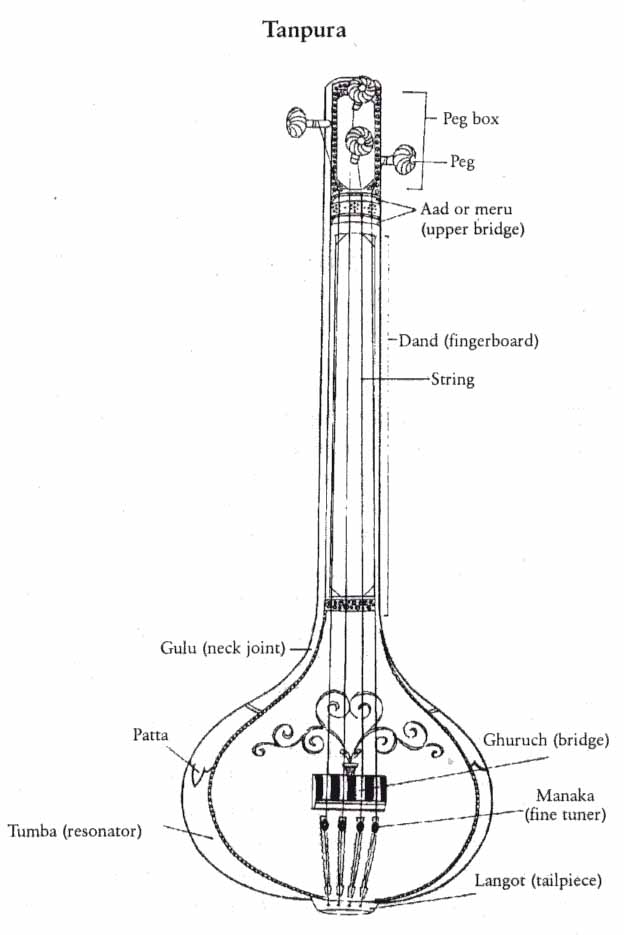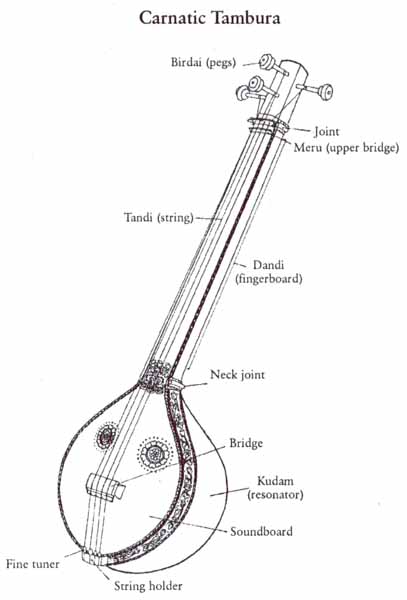Kleines Lexikon indischer Instumente
Der Text ist in gekürzter Form von Suneera Kasliwal, Classical Musical Instruments, Delhi 2001, entnommen.
Tanpura
The tanpura is a drone instrument of Indian music prevalent in both the Hindustani and the Carnatic systems. It plays an important role in a concert of classical music by providing the base note (adharaswara) and by creating an aesthetic ambience on the stage. A well-tuned tanpura can emit possibly all the seven notes of the gamut. The tanpura by its function of providing a background, provides neither a specific note nor a rhythm. It creates a circle of certain pitches which by themselves do not produce a melody. Therefore, it will be more apt if we say that the tanpura creates a melodic background, but not a melody. Thus the tanpura provides a drone, i.e. adhar swara, designed to create a musical state in which an artist enjoys the fullest possible freedom to explore the different elements of the music. The continuous drone of the tanpura can also impart a musical continuity, especially to the plucked and struck instruments, which do not possess a musical continuity in their sound production. Tambora, tambura, tumbura or tamura all are synonyms of the Tanpura, which is relatively a new nomenclature given to it in Northern Indian music, wheras in Carnatic music it is still called tambura.
The tanpura has a hollow body. The body is a carefully designed soundbox. It consists of the front of the tanpura, called the soundboard (tabli), the gourd (tumba) and the neck heel (gulu) at the back of the fingerboard. The tanpura is a plucked chordophone. The vibrations set up by the plucking of strings are conveyed to the resonator through the bridge and the resonating plank (tabli). The air cavity inside the tumba and the rest of the body is set into forced vibrations, which leads to the amplification and projection of the basic tone.
The best wood to make tanpuras from is Spanish Cedar (tun wood). Teak is also used for this purpose. The wood used should be well seasoned or kiln-dried so that it stands up to the changes in temperature as well as humidity. Tanpuras are of two types, male and female. The total length of the male tanpura is fifty-seven inches, the width of the soundboard (tabli) seventeen inches, circumference of the gourd (tumba) is fifty-four inches, and the length of the neck (dandi) or fingerboard is forty inches. The measurements of the female tanpura are fifty-one, fifteen, forty-eight and thirty-six inches respectively.
The polishing is done by hand, preferably with the French Sheller with a spirit base. But before it is polished, the body is made smooth by sandpaper. The polish has to be dried for at least fifteen days before fitting the pegs and bridges for good results. The fittings of the tanpura are: khunti (pegs), targahan (nuts), javari (bridge), and strings. The wood used for pegs is preferably seasoned rosewood, and the bridge and nuts are preferably made out of a stag horn. All the joints of the tanpura's body are very important and, therefore, should be treated consciously. The tanpuras are decorated with fine inlay work and wooden leaf patterns to give it a much better appearance. There are four metal strings, three are made of steel and the fourth and the lowest one is of brass.
Carnatic tamburas usually have wooden bodies. The most preferred wood to make the body is jack wood. In appearance the tambura is like the southern veena without the second gourd. The bowl is usually a large one, from ten to eighteen inches wide. The overall length of the instrument varies from three-and-a-half feet to five feet. The body is usually slightly convex. The bridge is made of ivory or wood. The most important part of the tanpura or tambura is the wide bridge made out of different materials — ebony wood or ivory, stag horn or even camel bone. Innovative tanpuras: Looking at the increasing demand for compact, portable and easy-to-handle tanpuras for travel purposes, efforts have been made to redesign its large and fragile body, and to produce smaller, compact instruments with a satisfactorily ambient sound, and a clear sustaining tonic centre.
The newly-developed tanpura, better known as tamburi, is a perfectly designed instrument so far as its sound, tone, volume and compactness are concerned. The soundbox assembly is made without the gourd (tumba) and neck heel (gulu). It is hollowed out of a single wooden base, preferably tun, and carved in such a manner that it is able to perform the same function as that of the tumba, and is merely thirty-eight-and- a-half inches long. The instrument can be tuned to variable notes with the shuffling of different gauged strings.

